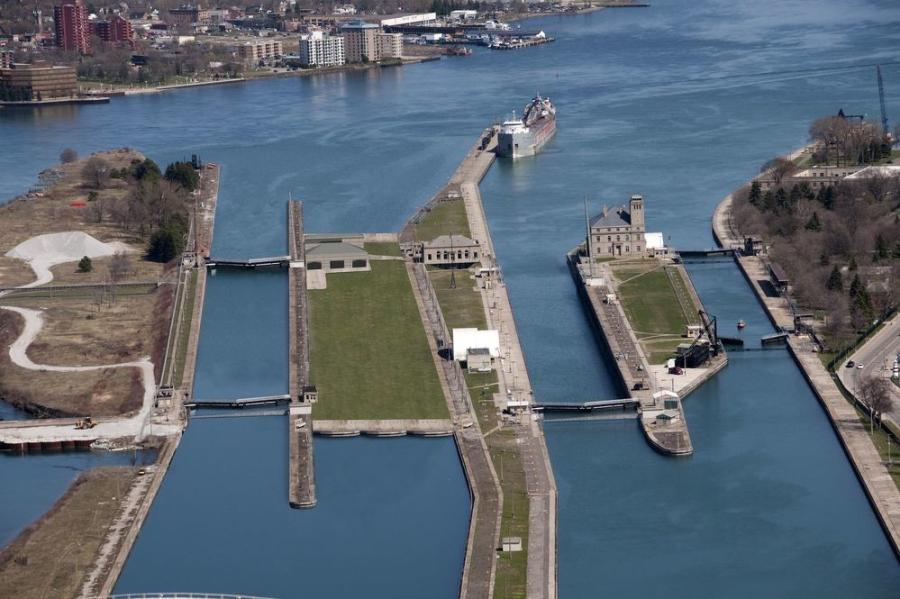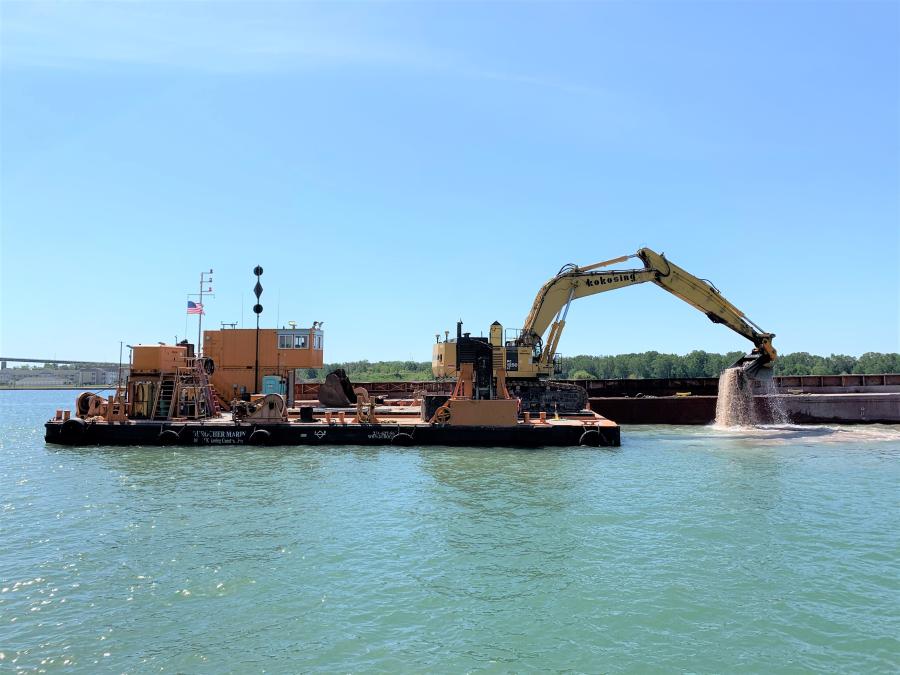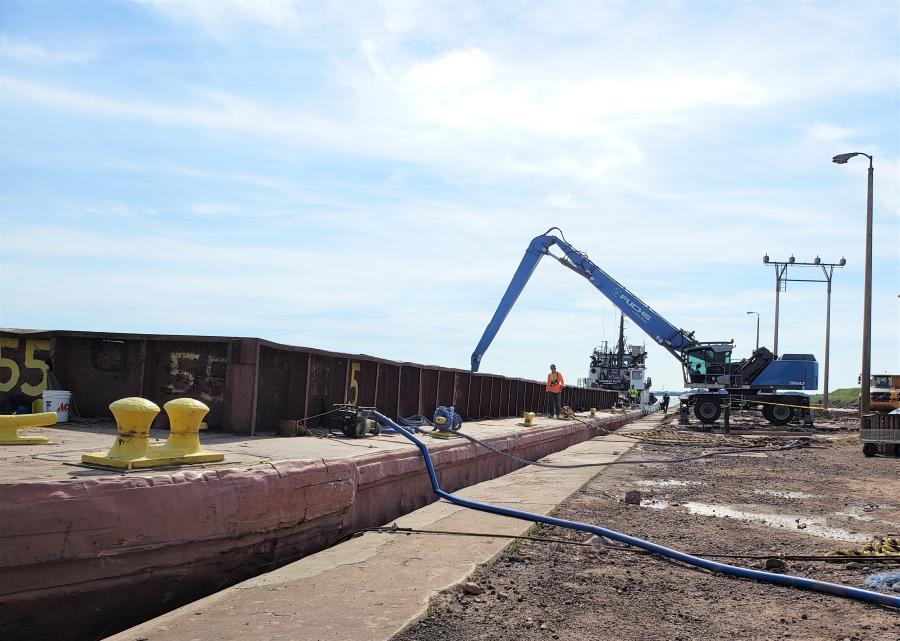An artist’s rendition that illustrates what it might look like if a second Poe-sized lock replaced two of the older locks.
(U.S. Army Corps of Engineers photo)
Iron ore-carrying vessels don't do rapids, particularly when heading upstream. To get around them, structures called "locks" are built — sort of stairs for boats. Vessels float into one end, entry gates are closed and the level of water inside the lock is raised or lowered to match the level outside the gates at the other end. Exit gates then are opened and the vessel floats away at a new elevation.
The U.S. Army Corps of Engineers operates locks at the eastern end of Lake Superior at Sault Ste. Marie, Mich., where the lake level drops 21 ft. via rapids into the St. Marys River. The river flows some 70 mi. farther east to Lake Huron. Vessels laden with iron ore make this critical eastward journey through the locks some 3,500 times a year to feed the Great Lakes steel-making industry and then return empty heading back to Minnesota for more ore.
Because "Sault" is French for "rapids" and is pronounced "soo," the complex of lift stations at Sault Ste. Marie is called the Soo Locks. The biggest one is Poe Lock, named for Orlando Poe, a Civil War engineer who designed the lock in 1895. The current Poe Lock replaced it in the 1960s but kept the name.
A new lock — still unnamed — is to be constructed just north of Poe and will replace two narrower locks. The years-long project will involve heavy barges and excavators, removal of prodigious amounts of river sediment, rock and demolition material and the pouring of hundreds of thousands of tons of concrete.
Here's the thing: In the end, the new lock won't be any bigger or more capable than the existing Poe Lock. All that work and no bragging rights to show for it? Whatever happened to the progressive notion of bigger and better?
Corps engineers explain that the decision to replicate the existing lock is because the whole purpose of the project is to create a redundancy. That is, engineers want to ensure that if one lock fails for some reason, the other one can accommodate lake vessels so the important haulage work won't be interrupted.
"The issue is that the existing Poe Lock is a single point of failure. Nearly all the iron ore from Minnesota passes through the lock," said Mollie Mahoney, the Corps' lock project manager "The new lock will be the same dimension and the two locks will be used concurrently."
Yes, but since the United States government is going to all this trouble and expense — an estimated $1 billion — why not build the new lock just a tad larger on the reasonable presumption that future vessels will be wider and longer and with a deeper draft?
"If the new lock were built larger than the existing Poe lock," Mahoney explained, "bigger ships would be built that couldn't pass through the Poe Lock. Then we would be back to having a lack of redundancy."
The logic is indisputable, though it seems to erect an obstacle to progress. In any event, Congress sets the dimensions. Both locks will be 110 ft. wide, 32 ft. deep and 1,200 ft. long.
**
Before construction starts on the new lock chamber in 2022, two other components of the project will get under way. The first — deepening the channel to the west of the proposed lock at a cost of $53 million — began earlier this year when Nevada contractor Trade West Construction brought 15 to 20 crew members and some heavy equipment to Sault Ste. Marie. For the rest of 2020 and part of next year, they will be creating a deeper upstream channel to serve the new lock, mirroring the eastern channel deepened a decade ago on the downstream side of the new lock.
The Trade West crew will systematically lower some 7,000 ft. of channel to a constant depth of 31 ft. That will mean removal of just 6 in. of sediment and loose rocks in the far western part of the 300-ft.-wide channel. Closer to the lock itself, 6 to 8 ft. of sediment and bedrock must be removed.
The underwater work is surprisingly precise, as Corps Resident Engineer Steve Pautz attests.
"We can get a lot closer than six inches to a desired depth. GPS systems on the equipment give the operator a real-time look at the depth of the bucket. After we complete sections of the work, we'll do a full hydrographic survey using multibeam sonar to ensure we've dug the channel to the correct depth."
Sediment and rock at the channel's bottom are being scooped up using a Komatsu 1250LC excavator mounted on a 50-ft.-long spud barge, a floating work platform anchored by three pointed I-beams driven into the bottom of the channel. With either a 5-cu. yd. or 8-cu. yd. bucket at the end of the boom, the excavator is raising the material from the water and depositing it onto a 100-ft.-long scow barge. As work progresses, the excavator's operator can retract the spuds and move either barge as needed using the boom and bucket.
In the initial dredging phase of the deepening work, when watery sediment and loose materials are being lifted from the bottom, five or six hours are required to load a scow. At which point, the barge is moved away by a tugboat operator and another scow moved into place. When the operation moves into the bedrock removal area, the solid material will fill the scow more quickly.
Loaded barges are pushed northeast and anchored along the north approach wall of the channel. There, a Fuchs MHL360 material handler with a 2.5-cu. yd. clamshell bucket unloads the material into a pair of Volvo A40 articulated trucks. The trucks haul the material to an adjacent dumpsite and a Caterpillar D8T dozer spreads it.
With the deepening project only about 25 percent complete, the mounded dirt bordering the channel already is more than 20 ft. tall.
"We built a hill," Pautz said. "It sticks up a fair amount and actually reduces crosswinds. Some captains expect it will make their lives a little easier in navigating the channel."
When the excavator barge runs out of sediment to dig up and begins to encounter sandstone bedrock, the excavation tools will change. Two Volvo EC750 excavators and a Komatsu PC360 excavator used in site preparation work are having their booms extended and are being fitted with rock-breaking tools, including a hydraulic hammer and a milling machine. One way or the other, the hardened glacial sediment beneath the water is going to be broken up and removed.
"We can generate 30,000 psi of force from an excavator and the bedrock is rated at only 15,000 psi. The only challenge is if we find material too heavy or hard to get through or a single boulder that might be too heavy to lift out," Pautz said. In such an eventuality, the betting is on the engineers figuring out a way to move it.
Increasing the depth of the channel is not a consequence of siltation, Pautz pointed out. Unlike the bottoms of busy rivers where seasonal flow moves and drops lots of sediment, the east end of Lake Superior is simply too shallow and always has been. It must be deepened as modern technology produces vessels requiring more depth. Today's 1,100-ft.-long, 100-ft.-wide ore carriers extend 26 ft. below the surface when loaded and several feet less when empty.
The second phase of the overall lock project is building of a new upstream approach wall replacing a century-old one. A contract for the wall will be awarded later this year and construction of it will take almost two years.
"The current wall is a combination of lumber and concrete with wooden impact timbers hung on the side of it," said Pautz. "It runs for 7,000 feet. The new wall will have sheet pile walls that transition into a 15-to-20-foot-thick concrete barrier closer to the lock itself for when fully loaded freighters ride along the face of the wall."
**
The new lock itself — the actual chamber in which vessels will be lifted or lowered to another water level — is still in the design stage and won't be contracted out until 2022, nor completed until 2027 at the earliest. Some of that construction time will accrue during winter months when contractors may or may not be able to work in Sault Ste. Marie, where 120 in. of snow fall each winter and January temperatures average minus 11 degrees.
Though the start of the lock chamber's construction is more than a year away, that doesn't mean Corps of Engineers personnel aren't fully conversant about the project.
The lead engineer for the lock work, Darin White, said the first task will be to build coffer dams and dewater the narrower Sabin Lock that sits in the footprint of the new lock. The dams will give demolition crews and, eventually, construction crews a dry work area. Rock in the coffer dams will be grouted and soil sealed, though in all probability it will be a futile effort to stop leakage.
"I've worked on similar projects and there always is some water that makes it in," White said.
The area between the dams now contains two decommissioned locks — Sabin and Davis — and will be transformed into one larger lock and a paved operating area. As the Sabin Lock is disassembled and demolished, concrete debris will go to one fill site, and excavated rock and soil will be dumped in the other decommissioned lock (Davis), totally infilling it. Only then can construction of the new lock begin.
Building the new chamber will require, according to White, 735,000 tons of quarry stone; 35,000 tons of American-made cement; and 20,000 tons of American-made steel. A concrete batch plant will be set up on the north side of the new lock.
The lock's walls will be built first. They will be comprised of a series of concrete monoliths — White compares them to giant Lego blocks — standing some 70 ft. high. Each monolith will be poured in 5-ft.-high segments, meaning each one will require about 15 pours. Every other monolith will be formed and poured — that is, a space will be left between each one — an efficient plan because the skipped monoliths already will have two sides in place when it comes time to form them. The wall will be 10 ft. thick at the top and 40 ft. thick at the bottom.
The floor of the chamber will be 3 ft. of concrete. White said the floor really has two functions. The first is to act as a strut, bracing the bottoms of each side wall so they don't move inward. The real pressure on the walls, White noted, is not the enormous volume of water (compressed by a ship's weight) pressing outward, it is the inward press of earthen fill when the chambers are emptied each winter for 10 weeks of cleaning and maintenance. That is when the concrete floor also is valuable as a solid surface for maintenance crews inspecting and repairing the emptied chamber.
"There always is something to be repaired," White said of the annual maintenance work. "At Poe, there was a chunk of concrete missing from one end, and an issue with some valves. You have to expect things to fail as they get some age on them."
The concrete walls will be somewhat protected by wall armor, that is, metal strips hung vertically to absorb some of the impact when vessels "bang" it.
Each leaf of the paired gates on the ends of the lock — they are taller on the Superior side of the chamber — will be 61 ft. wide and weigh more than 200 tons. The gates, incidentally, are the exact dimensions of the ones on the Poe Lock for ease of maintenance and to minimize spare parts. They will be manufactured elsewhere, shipped to the site and assembled in place.
When the new lock is in service, it like the others will be gravity-flooded when a ship is moving upstream and needs a lift or downstream and needs to be lowered. When needed, lock operators can call on three 40,000-gal.-per-minute pumps to quickly rid the chamber of excess water.
That's the plan at this point, about 70 percent of the way through the design stage. When the contract is let and lock construction begins in earnest, some 600 contract workers will swarm the site during peak work periods.
When the length of a construction project is measured in years, it can be easy to lose perspective from week to week. So many things can go wrong over such a long span of time. But for now, said Pautz, the resident engineer, "we are ahead of schedule." CEG
Today's top stories
























